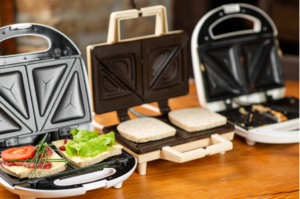Table of Contents
Types of Can Openers
There are several types of can openers, each with its unique design and method of operation. Understanding these differences is the first step in mastering their use.
1. Manual Can Openers
1.1.1 Butterfly Can Opener
The butterfly opener, also known as the swing-a-way or traditional opener, features a rotating cutting wheel and a handle. It’s one of the most common types and is often found in many households.
1.1.2 Church Key Can Opener
The church key opener is a simple tool with a pointed end used to puncture cans. It is less commonly used for food cans today but is still handy for opening beverage cans and bottles.
1.1.3 Side-Cutting Can Opener
A side-cutting opener, also known as a safety opener, cuts along the side of the can below the rim, creating a smooth edge and preventing sharp edges.
2. Electric Can Openers
1.2.1 Countertop Electric Can Opener
This type of opener sits on your countertop and is operated by plugging it into an electrical outlet. It’s convenient for those who open cans frequently or have difficulty using manual openers.
1.2.2 Handheld Electric Can Opener
A handheld electric opener is portable and battery-operated. It’s a compact option that combines the ease of an electric opener with the convenience of portability.
3. Specialty Can Openers
1.3.1 Military Can Opener (P-38 and P-51)
These small, portable openers are designed for military use and are compact enough to fit on a keychain. They require some manual effort but are highly effective.
1.3.2 Multi-Tool Can Opener
Often found on Swiss Army knives or other multi-tools, these openers are versatile and convenient for outdoor activities.
How to Use a Can Opener
We can use a opener according to different ways. Here we discuss about how to use can opener:
1. Using a Butterfly Can Opener
Positioning: Place the can on a stable surface. Open the handles of the opener and position the cutting wheel on the edge of the can’s lid.
Clamping: Close the handles to puncture the lid with the cutting wheel. Ensure the wheel is securely positioned.
Rotating: Turn the knob or crank clockwise, allowing the cutting wheel to rotate around the can’s rim. Continue until you’ve cut the entire lid.
Removing the Lid: Lift the lid carefully. If it’s stuck, use the opener’s built-in lid lifter or a fork to remove it.
2. Using a Church Key Can Opener
Positioning: Hold the can firmly on a stable surface.
Puncturing: Insert the pointed end of the church key into the top edge of the can.
Levering: Use a rocking motion to puncture the lid, then lever the church key to create a larger opening.
Repeating: Continue this process around the edge of the can until you have an adequate opening to pour or scoop out the contents.
3. Using a Side-Cutting Can Opener
Positioning: Place the can on a stable surface and position the side-cutting wheel just below the can’s rim.
Clamping: Close the handles to secure the can opener in place.
Rotating: Turn the knob or crank clockwise, allowing the cutting wheel to rotate around the can’s circumference. The opener will cut along the side of the can.
Removing the Lid: Carefully lift the lid away from the can. The smooth edge makes it safer to handle.
4. Using a Countertop Electric Can Opener
Positioning: Place the can under the cutting blade of the electric can opener.
Engaging: Press the lever or button to engage the cutting blade and start the motor.
Rotating: The can will rotate automatically as the blade cuts through the lid.
Stopping: The opener will usually stop automatically once the lid is fully cut. Lift the lever to release the can.
Removing the Lid: Carefully remove the lid and dispose of it.
5. Using a Handheld Electric Can Opener
Positioning: Position the handheld electric opener on the can’s edge.
Engaging: Press the button to start the motor and engage the cutting blade.
Rotating: Hold the opener in place as it rotates around the can’s lid.
Stopping: Release the button once the opener has completed the cut.
Removing the Lid: Carefully remove the lid and dispose of it.
6. Using a Military Can Opener (P-38 and P-51)
Positioning: Hold the can firmly on a stable surface.
Engaging: Insert the blade of the P-38 or P-51 into the can’s lid near the edge.
Levering: Use a rocking motion to puncture the lid, then lever the blade to cut through the lid.
Repeating: Continue this process around the edge of the can until the lid is completely cut.
Removing the Lid: Carefully lift the lid away from the can.
Tips for Safe and Effective Use
1. General Safety Tips
Keep Blades Sharp: Dull blades can slip and cause accidents. Regularly sharpen or replace the cutting wheel.
Clean Regularly: Clean your opener after each use to prevent the buildup of food residues and bacteria.
Store Properly: Store your opener in a dry place to prevent rusting, and keep it out of reach of children.
2. Specific Tips for Different Types of Can Openers
Butterfly Can Opener: Ensure the handles are firmly closed to prevent the opener from slipping.
Church Key Can Opener: Be cautious of sharp edges and punctures.
Side-Cutting Can Opener: These openers leave a smooth edge, reducing the risk of cuts. They’re ideal for households with children.
Electric Can Opener: Ensure the can is positioned correctly and hold it steady to prevent it from tipping over.
Military Can Opener: Use a firm grip and be patient. These tools require more effort but are highly effective in emergencies.
Maintenance and Troubleshooting
Maintenance Tips
Regular Cleaning: After each use, wash the cutting wheel and handles with warm soapy water. Dry thoroughly to prevent rust.
Lubrication: Occasionally apply a drop of food-grade oil to the cutting wheel’s pivot points to ensure smooth operation.
Blade Replacement: If the cutting wheel becomes dull, replace it according to the manufacturer’s instructions.
Troubleshooting Common Issues
Can Opener Won’t Cut: Check if the blade is dull and needs sharpening or replacing. Ensure the opener is positioned correctly on the can.
Handles Won’t Close: Inspect for food debris obstructing the mechanism. Clean thoroughly and lubricate if necessary.
Electric Can Opener Won’t Start: Ensure it’s plugged in properly and check for any blown fuses or circuit breakers. For battery-operated models, check the batteries and replace them if needed.
Choosing the Right Can Opener
Factors to Consider
Frequency of Use: For frequent use, an electric opener might be more convenient. For occasional use, a manual opener may suffice.
Ease of Use: Consider the ease of use, especially for individuals with arthritis or limited hand strength.
Safety Features: Look for safety features such as smooth-edge cutting and non-slip grips.
Durability: Choose a opener made of durable materials, such as stainless steel, to ensure longevity.
Recommendations
Best Manual Can Opener: The OXO Good Grips Smooth Edge Opener is highly recommended for its ergonomic design and smooth-edge cutting.
Best Electric Can Opener: The Hamilton Beach Smooth Touch Electric Opener is popular for its ease of use and reliable performance.
Best Budget Can Opener: The Kuhn Rikon Auto Safety Master Opener offers excellent performance at an affordable price.
Historical Overview
Invention of the Can Opener
The can opener was invented following the introduction of the tin can in the early 19th century. Initially, cans were opened using knives and other sharp tools, but this was neither safe nor efficient.
Evolution of Can Openers
1855: The first can opener patent was granted in England to Robert Yeates, featuring a lever and pointed blade design.
1870: William Lyman patented the rotary opener, which became the basis for modern designs.
1925: The Star Can Opener Company introduced the first serrated wheel opener.
1980s: The development of electric openers provided a convenient alternative to manual models.
Modern Innovations
Recent innovations have focused on safety, ease of use, and multi-functionality, leading to the development of smooth-edge and ergonomic designs.
Environmental and Practical Considerations
Recycling and Disposal of Cans
Recycling: Ensure cans are rinsed and free of food residues before recycling.
Upcycling: Consider upcycling cans for storage, plant pots, or craft projects.
Practical Uses of Opened Cans
Storage: Use opened cans to store small kitchen items such as utensils or spices.
Craft Projects: Cans can be decorated and repurposed for various craft projects, adding a creative touch to your home.
Conclusion
Using a can opener is a fundamental kitchen skill that enhances your culinary efficiency and safety. By understanding the different types of openers, learning how to use them correctly, and following proper maintenance tips, you can ensure that your opener remains a reliable tool in your kitchen. Whether you prefer a manual or electric model, choosing the right opener for your needs will make opening cans a simple and hassle-free task.
FAQs:
1. What types of openers are there?
There are several types of opener, including manual openers (such as butterfly and church key openers), electric openers (countertop and handheld), and specialty openers (such as military P-38/P-51 and multi-tool openers).
2. How do I use a manual butterfly opener?
Place the cutting wheel on the edge of the can’s lid, clamp the handles together to puncture the lid, and then turn the knob clockwise to rotate the cutting wheel around the can. Lift the lid carefully once it’s fully cut.
3. What is the correct way to use a church key opener?
Hold the can firmly, insert the pointed end of the church key into the top edge of the can, and use a rocking motion to puncture the lid. Continue this process around the can until you have an adequate opening.
4. How does a side-cutting can opener work?
Position the side-cutting wheel below the can’s rim, clamp the handles to secure the opener, and turn the knob clockwise to rotate the cutting wheel around the can. The opener will cut along the side of the can, creating a smooth edge.
5. How do I use an electric opener?
Place the can under the cutting blade of the electric opener, press the lever or button to engage the blade and start the motor. The can will rotate automatically as the blade cuts through the lid. Lift the lever to release the can once the cutting is complete.
6. What should I do if my can opener won’t cut?
Check if the blade is dull and needs sharpening or replacing. Ensure the can opener is positioned correctly on the can and that there’s no food debris obstructing the mechanism.
7. How can I keep my can opener clean?
Wash the cutting wheel and handles with warm, soapy water after each use and dry thoroughly to prevent rust. Occasionally, apply a drop of food-grade oil to the cutting wheel’s pivot points to ensure smooth operation.
8. Is there a specific can opener recommended for people with arthritis?
Yes, electric openers and side-cutting manual openers are often recommended for people with arthritis due to their ease of use and reduced strain on the hands.
9. How do I safely remove the lid after opening a can?
Use the opener’s built-in lid lifter or a fork to lift the lid carefully. Be cautious of any sharp edges, especially with traditional manual openers.
10. Can I recycle opened cans?
Yes, most cans are recyclable. Rinse the can to remove any food residues before placing it in your recycling bin. Check your local recycling guidelines for specific requirements.
11. How often should I replace my can opener?
Replace your opener when the blade becomes too dull to cut effectively, or if it shows signs of rust or wear that cannot be remedied by cleaning or sharpening.
12. Are there safety can openers available?
Yes, side-cutting or safety openers are designed to create a smooth edge, reducing the risk of cuts. These are particularly useful in households with children.
13. How do military can openers (P-38/P-51) work?
Insert the blade into the can’s lid near the edge and use a rocking motion to puncture and cut through the lid. Continue around the can until the lid is completely cut and then carefully lift it away.
14. Can I use a multi-tool can opener for food cans?
Yes, multi-tool openers found on Swiss Army knives or similar tools can be used to open food cans, but they may require more manual effort and precision.
By understanding the different types of openers and learning how to use them properly, you can ensure safe and efficient can opening in your kitchen.



